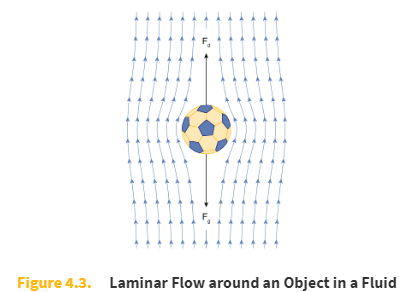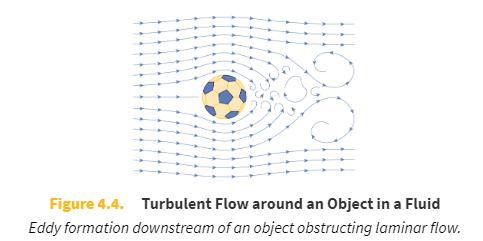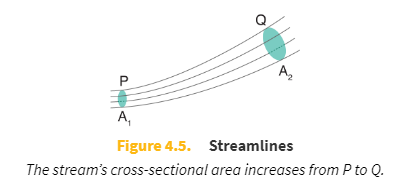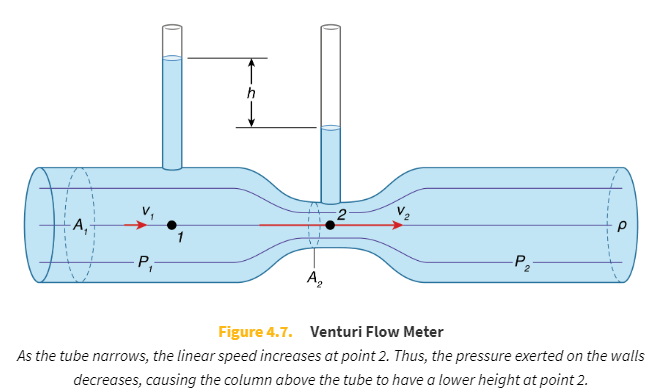-
Fluid dynamics
Fluid dynamics is the study of fluids in motion.
-
The MCAT presents a relatively simplified version of fluid dynamics, making important assumptions such as _____ and _____.
rigid-walled containers and uniform density of fluids
-
Viscosity (with symbol)
The resistance of a fluid to flow is called viscosity (η).
-
Viscous drag
A nonconservative force that is analogous to air resistance.
-
Increased viscosity of a fluid _____ its viscous drag.
increases
-
All fluids (except _____, which are not tested on the MCAT) are viscous to one degree or another.
superfluids
-
Fluids with lower viscosities are said to behave more like ideal fluids, which have _____ and are described as _____.
no viscosity
inviscid
-
More viscous fluids will _____ while flowing.
“lose” more energy
-
Unless otherwise indicated, viscosity should be assumed to be _____ on Test Day,
negligible
-
SI unit of viscosity

pascal-second
-
Assume conservation of energy in ...
... low-viscosity fluids with laminar flow.
-
Laminar flow

Laminar flow is smooth and orderly, and is often modeled as layers of fluid that flow parallel to each other, as shown in Figure 4.3.
(Note: The layers will not necessarily have the same linear speed.)
-
With laminar flow through a pipe or confined space, it is possible to calculate the rate of flow using _____.
Poiseuille’s law
-
Poiseuille’s law equation

Q is the flow rate (volume flowing per time)
r is the radius of the tube
ΔP is the pressure gradient
η (eta) is the viscosity of the fluid
L is the length of the pipe
-
The relationship between the radius and pressure gradient is _____. Thus, increasing the radius of a pipe is expected to _____ the pressure of the fluid, and vice versa.
inverse exponential to the fourth power
greatly decrease
-
Turbulent flow

Turbulent flow is rough and disorderly, and causes the formation of eddies.
-
Eddies
Swirls of fluid of varying sizes occurring typically on the downstream side of an obstacle.
-
Critical speed
Critical velocity is the speed and direction at which the flow of a liquid through a tube changes from smooth to turbulent.
-
Boundary layer
The thin layer of fluid adjacent to the wall where lamina flow occurs during turbulent flow.
-
The flow speed immediately at the wall is _____ and _____throughout the boundary layer.
zero
increases uniformly
-
Calculations of energy conservation _____ be applied to turbulent flow systems.
cannot
-
Critical speed formula

vc is the critical speed
NR is a dimensionless constant called the Reynolds number
η is the viscosity of the fluid
ρ is the density of the fluid
-
Reynolds number
A dimensionless constant that depends on factors such as the size, shape, and surface roughness of any objects within the fluid.
-
Streamlines

Streamlines indicate the pathways followed by tiny fluid elements (sometimes called fluid particles) as they move.
-
The velocity vector of a fluid particle will always be _____ to the streamline at any point.
tangential
-
The rate at which a given volume (or mass) of incompressible fluid passes by one point must be _____ in a closed system.
the same for all other points
-
Flow rate
volume per unit time
-
The flow rate is _____ for a closed system and is independent of _____.
constant
changes in cross-sectional area
-
Linear speed
Linear speed is a measure of the linear displacement of fluid particles in a given amount of time.
-
Continuity equation
Q = v1A1 = v2A2
Q is the flow rate
v1 and v2 are the linear speeds of the fluid at points 1 and 2
A1 and A2 are the cross-sectional areas at points 1 and 2
-
Linear speed of a fluid will _____ with decreasing cross-sectional area.
increase
-
The continuity equation arises from the _____ of fluids.
conservation of mass
-
Fluids that have low viscosity and demonstrate laminar flow can also be approximated to be _____.
conservative systems
-
Bernoulli’s equation

P is the absolute pressure of the fluid
ρ is the density of the fluid
v is the linear speed
g is acceleration due to gravity
h is the height of the fluid above some datum
-
Dynamic pressure component of Bernoulli's equation

-
Dynamic pressure
The pressure associated with the movement of a fluid
-
Dynamic pressure is essentially the ...
... kinetic energy of the fluid divided by volume.
-
The term ρgh in Bernoulli's equation is essentially ...
... the pressure associated with the mass of fluid sitting above some position.
-
Energy density
A ratio of energy per unit volume
-
Pressure can be thought of as _____. Why?

energy density
Multiply units of pressure (N/m^2) * (m/m) to get J/m^3
-
Static pressure component of Bernoulli's equation
P + ρgh
-
Static pressure
The pressure associated with a fluid at rest (can be thought of as absolute pressure)
-
Bernoulli’s equation states, then, that the _____ will be constant. (assumptions?)
sum of the static pressure and dynamic pressure
Assume that the fluid is incompressible and has no viscous drag, and that the container is closed.
-
More energy dedicated toward fluid movement means _____ energy dedicated toward static fluid pressure.
less
-
Pitot tubes
Specialized measurement devices that determine the speed of fluid flow by determining the difference between the static and dynamic pressure of the fluid at given points along a tube
-
Venturi flow meter key points

1. The average height of the tubes remains constant (see: points 1 and 2); Thus, ρgh remains constant at points 1 and 2.
2. When a decrease in absolute pressure is experienced at the wall adjacent to point two due to increased linear speed of the fluid, the column of water will get shorter.
-
Venturi effect
The reduction in fluid pressure that results when a fluid flows through a constricted section (or choke) of a pipe.
-
The Venturi effect is the combination of _____ and _____.
Bernoulli's equation
the continuity equation

